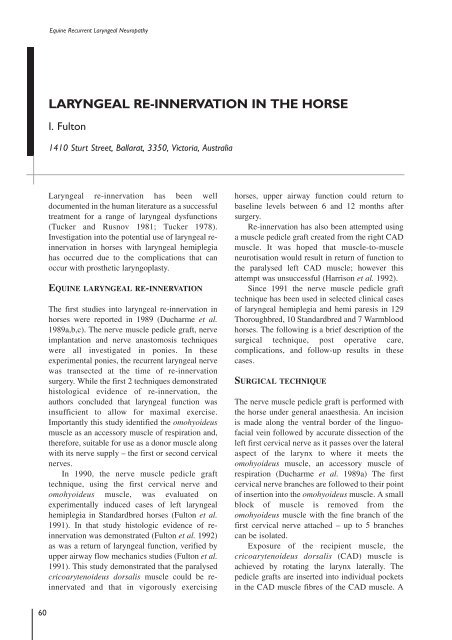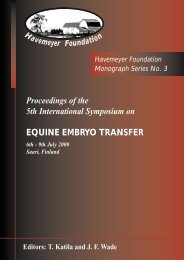Proceedings of a Workshop on - The Havemeyer Foundation
Proceedings of a Workshop on - The Havemeyer Foundation
Proceedings of a Workshop on - The Havemeyer Foundation
Create successful ePaper yourself
Turn your PDF publications into a flip-book with our unique Google optimized e-Paper software.
Equine Recurrent Laryngeal Neuropathy<br />
LARYNGEAL RE-INNERVATION IN THE HORSE<br />
I. Fult<strong>on</strong><br />
1410 Sturt Street, Ballarat, 3350, Victoria, Australia<br />
Laryngeal re-innervati<strong>on</strong> has been well<br />
documented in the human literature as a successful<br />
treatment for a range <str<strong>on</strong>g>of</str<strong>on</strong>g> laryngeal dysfuncti<strong>on</strong>s<br />
(Tucker and Rusnov 1981; Tucker 1978).<br />
Investigati<strong>on</strong> into the potential use <str<strong>on</strong>g>of</str<strong>on</strong>g> laryngeal reinnervati<strong>on</strong><br />
in horses with laryngeal hemiplegia<br />
has occurred due to the complicati<strong>on</strong>s that can<br />
occur with prosthetic laryngoplasty.<br />
EQUINE LARYNGEAL RE-INNERVATION<br />
<strong>The</strong> first studies into laryngeal re-innervati<strong>on</strong> in<br />
horses were reported in 1989 (Ducharme et al.<br />
1989a,b,c). <strong>The</strong> nerve muscle pedicle graft, nerve<br />
implantati<strong>on</strong> and nerve anastomosis techniques<br />
were all investigated in p<strong>on</strong>ies. In these<br />
experimental p<strong>on</strong>ies, the recurrent laryngeal nerve<br />
was transected at the time <str<strong>on</strong>g>of</str<strong>on</strong>g> re-innervati<strong>on</strong><br />
surgery. While the first 2 techniques dem<strong>on</strong>strated<br />
histological evidence <str<strong>on</strong>g>of</str<strong>on</strong>g> re-innervati<strong>on</strong>, the<br />
authors c<strong>on</strong>cluded that laryngeal functi<strong>on</strong> was<br />
insufficient to allow for maximal exercise.<br />
Importantly this study identified the omohyoideus<br />
muscle as an accessory muscle <str<strong>on</strong>g>of</str<strong>on</strong>g> respirati<strong>on</strong> and,<br />
therefore, suitable for use as a d<strong>on</strong>or muscle al<strong>on</strong>g<br />
with its nerve supply – the first or sec<strong>on</strong>d cervical<br />
nerves.<br />
In 1990, the nerve muscle pedicle graft<br />
technique, using the first cervical nerve and<br />
omohyoideus muscle, was evaluated <strong>on</strong><br />
experimentally induced cases <str<strong>on</strong>g>of</str<strong>on</strong>g> left laryngeal<br />
hemiplegia in Standardbred horses (Fult<strong>on</strong> et al.<br />
1991). In that study histologic evidence <str<strong>on</strong>g>of</str<strong>on</strong>g> reinnervati<strong>on</strong><br />
was dem<strong>on</strong>strated (Fult<strong>on</strong> et al. 1992)<br />
as was a return <str<strong>on</strong>g>of</str<strong>on</strong>g> laryngeal functi<strong>on</strong>, verified by<br />
upper airway flow mechanics studies (Fult<strong>on</strong> et al.<br />
1991). This study dem<strong>on</strong>strated that the paralysed<br />
cricoarytenoideus dorsalis muscle could be reinnervated<br />
and that in vigorously exercising<br />
horses, upper airway functi<strong>on</strong> could return to<br />
baseline levels between 6 and 12 m<strong>on</strong>ths after<br />
surgery.<br />
Re-innervati<strong>on</strong> has also been attempted using<br />
a muscle pedicle graft created from the right CAD<br />
muscle. It was hoped that muscle-to-muscle<br />
neurotisati<strong>on</strong> would result in return <str<strong>on</strong>g>of</str<strong>on</strong>g> functi<strong>on</strong> to<br />
the paralysed left CAD muscle; however this<br />
attempt was unsuccessful (Harris<strong>on</strong> et al. 1992).<br />
Since 1991 the nerve muscle pedicle graft<br />
technique has been used in selected clinical cases<br />
<str<strong>on</strong>g>of</str<strong>on</strong>g> laryngeal hemiplegia and hemi paresis in 129<br />
Thoroughbred, 10 Standardbred and 7 Warmblood<br />
horses. <strong>The</strong> following is a brief descripti<strong>on</strong> <str<strong>on</strong>g>of</str<strong>on</strong>g> the<br />
surgical technique, post operative care,<br />
complicati<strong>on</strong>s, and follow-up results in these<br />
cases.<br />
SURGICAL TECHNIQUE<br />
<strong>The</strong> nerve muscle pedicle graft is performed with<br />
the horse under general anaesthesia. An incisi<strong>on</strong><br />
is made al<strong>on</strong>g the ventral border <str<strong>on</strong>g>of</str<strong>on</strong>g> the lingu<str<strong>on</strong>g>of</str<strong>on</strong>g>acial<br />
vein followed by accurate dissecti<strong>on</strong> <str<strong>on</strong>g>of</str<strong>on</strong>g> the<br />
left first cervical nerve as it passes over the lateral<br />
aspect <str<strong>on</strong>g>of</str<strong>on</strong>g> the larynx to where it meets the<br />
omohyoideus muscle, an accessory muscle <str<strong>on</strong>g>of</str<strong>on</strong>g><br />
respirati<strong>on</strong> (Ducharme et al. 1989a) <strong>The</strong> first<br />
cervical nerve branches are followed to their point<br />
<str<strong>on</strong>g>of</str<strong>on</strong>g> inserti<strong>on</strong> into the omohyoideus muscle. A small<br />
block <str<strong>on</strong>g>of</str<strong>on</strong>g> muscle is removed from the<br />
omohyoideus muscle with the fine branch <str<strong>on</strong>g>of</str<strong>on</strong>g> the<br />
first cervical nerve attached – up to 5 branches<br />
can be isolated.<br />
Exposure <str<strong>on</strong>g>of</str<strong>on</strong>g> the recipient muscle, the<br />
cricoarytenoideus dorsalis (CAD) muscle is<br />
achieved by rotating the larynx laterally. <strong>The</strong><br />
pedicle grafts are inserted into individual pockets<br />
in the CAD muscle fibres <str<strong>on</strong>g>of</str<strong>on</strong>g> the CAD muscle. A<br />
60








